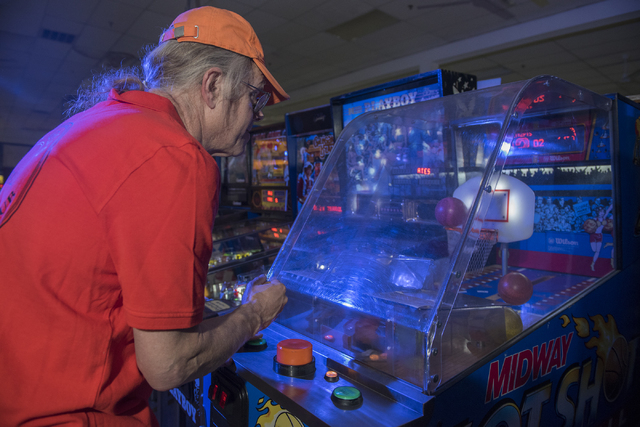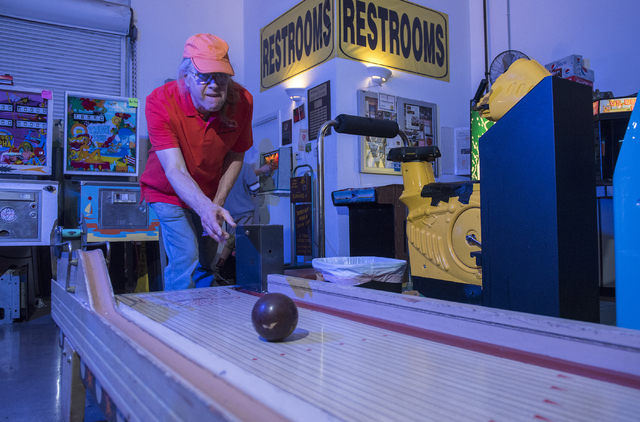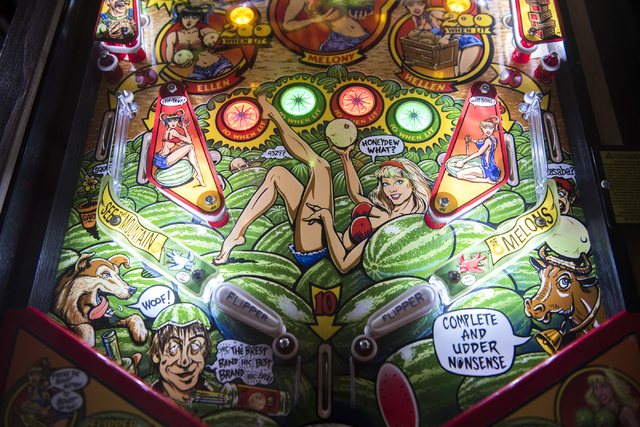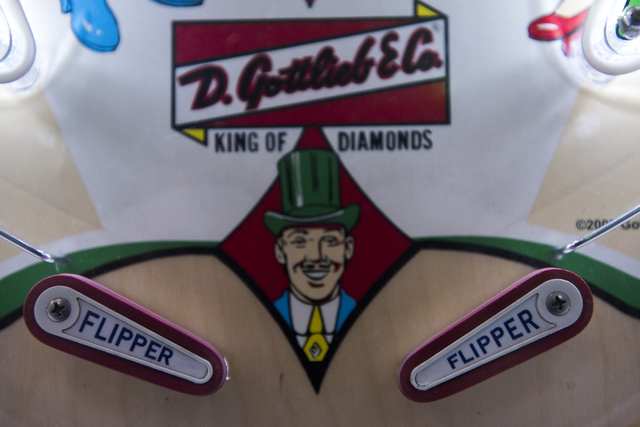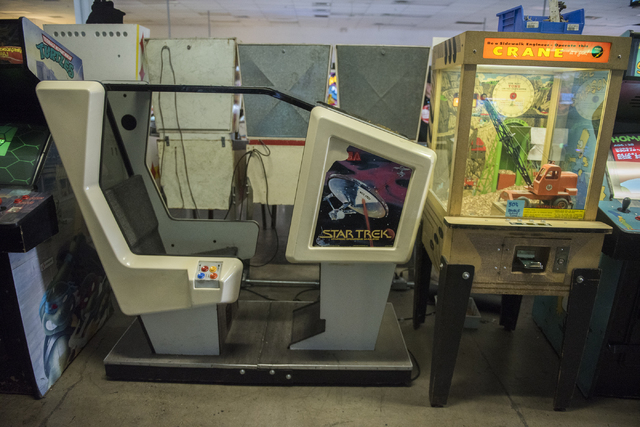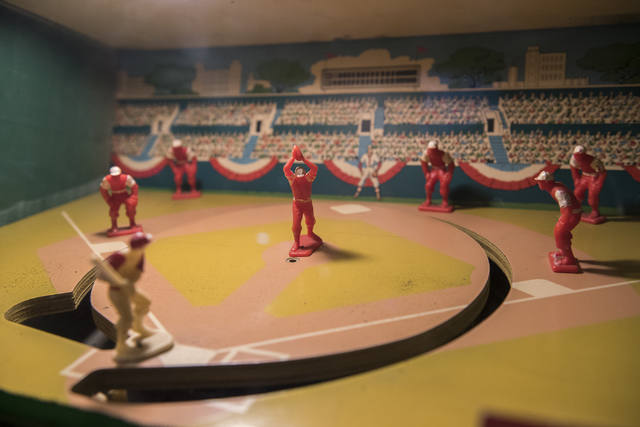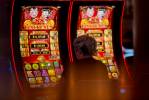Owner says Pinball Hall of Fame is alive and well in Las Vegas
Sure, it’s a great place to play pinball. But the Las Vegas Pinball Hall of Fame also is like any other museum where the past is remembered and celebrated, and where each piece — each pinball machine, each video game, each console game or arcade attraction — packs a story.
The only difference: While the Pinball Hall of Fame is cool with — and, in fact, encourages — guests to pump a few quarters into the 150-plus pieces it has on display, just try juggling a few moon rocks or trying on Fonzie’s jacket at the Smithsonian Institution.
And while it’s not the corner bar your dad used to take you to for a soda, the game arcade you hung out at after school or the pinball-packed snack shop at the beach that you remember from your youth, the machines hall’s machines are magically adept at re-creating the same vibe that haunted those places of idyllic youth.
The hall of fame (www.pinballmuseum.org), 1610 E. Tropicana Ave., is open daily from 11 a.m. to 11 p.m. Sunday through Thursday and 11 a.m. to midnight Friday and Saturday. Overseeing it all is Tim Arnold, who, on various days, might refer to himself as the hall’s “curator” or the more laid-back “director of things and stuff.”
Over the past few weeks, pinball fans may have come close to emotionally tilting because of news stories that seemed to suggest that Arnold was preparing to either hand off the museum to someone else or even close it down.
Arnold says he doesn’t plan on doing either anytime soon. In fact, Arnold says he’s considering building a new, “much larger” hall of fame on land next door to the hall that is owned by the nonprofit organization that operates the hall. So, he says, “if we were really intent on closing this up, we wouldn’t be discussing a (new) space four times the size of this one.”
“The thing is, it’s an intensely popular hit,” Arnold says, and the hall consistently is a highly recommended attraction on online review sites.
That’s amazing, he adds, because the hall is “up against million-dollar fountains at Bellagio and million-dollar volcanoes (at Mirage), and we’re in an old auto parts store on the edge of town competing with ideas like that.”
The hall also is “one of the few affordable things to do” in town, Arnold says. “You can walk in here for free and half the games still cost a quarter.
“So we wouldn’t be delivering this much product for this many hours a week if we weren’t … serious about what we’re doing. It doesn’t look like an end-game, it doesn’t smell like an end-game.”
Actually, the most intriguing story the hall’s games have to tell is Arnold’s own. He’s a nearly lifelong fan of pinball games who turned his interest in the games into a job when he was just a kid.
“I got my first machine at 14, in 1969,” he says. “Gottlieb’s ‘Mayfair.’ I still have it.”
At 16 and then throughout high school, Arnold was setting up his machines in local businesses.
“All the other kids had things like paper routes. They had to get up in the morning and slog through the snow and deliver newspapers and go around again to collect money and all of that,” he says. “All I had to do was show up at the pizza parlor to collect money out of my pinball machines.”
In 1976, Arnold and his brother opened what became a hugely popular pinball emporium in Lansing, Michigan, and, later, another in Ann Arbor. In 1990, Arnold sold his interest in the business and came to Las Vegas, bringing with him machines that would become occupants of the hall of fame, which opened first on East Tropicana Avenue and South Pecos Road before moving to its current location in 2009.
Every game has a story, told via a hand-printed card attached to each. Take, for instance, “Jig Saw,” an unsophisticated-looking but fascinating 1933 game that Arnold rebuilt.
“There are probably less than 10 of those in the world,” he says. “For me to put this out so the public can actually put coins in it is suicidal. All it’s going to take is one kid slamming this game, tipping it over. So the stupidest thing I could do is let the public touch it, let alone put quarters in it so they can play.”
Another novel piece is a more recent game, “Pinball Circus,” that’s so rare that, according to Arnold, only two exist.
The developer “spent a million-and-a-half dollars to make two games and then decided for whatever reason to not make it,” he says, “and the stupidest thing I could do is let the public touch it, but they can come in and put coins in it and actually play it.”
So why do it? “Because I’m a showman, and Las Vegas was built by showmen, not bean counters,” Arnold says. “Not by spreadsheets but by guys … who take a big step and present entertainment to the masses. That’s what we do.”
“I have another game. The factory designed and built parts for it but never assembled it,” Arnold says. “So, what if you were a movie nut and somebody came up to you and said, ‘When they filmed ‘Gone With the Wind,’ they also filmed the sequel but they never put it together. So here’s six boxes of film. If you want to put it together, you can make the sequel to ‘Gone With the Wind’ with the original actors.’
“This is the only one that exists in the world,” Arnold says. “I actually put a game together from parts.”
Southern Nevadans would appreciate 1959’s “Joker Ball” which, Arnold says, “is the game that video poker is based on. There are two of them left in the world, and this is one of them.”
Like any museum piece, each game is a reflection of its time. Arnold says the illustrations on the games’ glass back pieces, the style of dress worn by figures in those illustrations, the cabinetry and construction of the games and even the features incorporated into the games — the collection includes “Lady Robin Hood,” the first pinball game to have flippers, although the flippers work in a way no modern player would recognize — all can help a sharp-eyed fan tease out a game’s unique story.
Then there are the stories that we impose upon the machines. Pinball machines are able to vividly evoke memories in players because they’re tangible representations of our memories. Unlike, say, oldies or classic rock music, pinball “exists in the real world,” Arnold says.
Add to all of this the draw of nostalgia, and the effect on players can be downright mesmerizing.
“We call it freezing up,” Arnold says. “Tourists just stop dead when they see (a game) they spent a lot of their youth playing. They haven’t seen it in 40 years, but they see the game and freeze solid and say, ‘The. First. Time. I. Kissed. A. Girl. I. Was. Playing. This. Machine. At. The. Mall. I can’t believe it.’ ”
Ruti Jones of Atlanta visited the hall during a recent Las Vegas vacation. “We’re not big gamblers, really, so it’s kind of fun to have some alternative things to do,” she says.
Pinball is “more fun than video poker,” Jones says. “We did that yesterday and, actually, this is better.”
“It brings you back to your youth, playing the old games,” says Paula Ashe of St. Petersburg, Florida, who was making her second visit to the museum during her vacation.
Because so many of the games are classics — or, put another way: really old — keeping them running is a challenge.
“It’s incredibly hard to keep this stuff working,” says Arnold, who spends serious time on e-Bay searching out appliance motors, relays and electronic components that he can re-purpose for use in his machines.
“I routinely have to fabricate parts.” he says. “I make metal parts routinely. I’m using parts today I rejected five years ago.”
Arnold figures that, someday — not now, but someday — he probably will deliver the collection to someone else, but he seems in no hurry for that to happen.
“This,” Arnold says, surveying his mechanical, bumper-filled, flipper-flapping domain, “is the weirdest, greatest collection” in town.
Read more from John Przybys at reviewjournal.com. Contact him at jprzybys@reviewjournal.com and follow @JJPrzybys on Twitter.
RELATED
Pinball Hall of Fame annex offers vintage arcade experience
Pinball Hall of Fame at full tilt to aid social services




